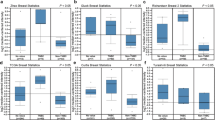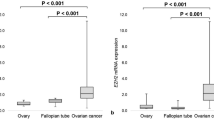Abstract
The purpose of this study is to investigate EZH2 in a large series of breast cancer patients for its prognostic and predictive value, and to evaluate its functional role in treatment response in vitro. EZH2 levels were measured using quantitative Real-Time Polymerase Chain Reaction (qRT-PCR) in primary breast cancer specimens and related to clinicopathologic factors and disease outcome. EZH2 expression was downregulated with siRNAs in MCF7, to assess expression alterations of putative EZH2 downstream genes and to determine cell numbers after treatment with the anti-estrogen ICI 164384. In 688 lymph node-negative patients who did not receive adjuvant systemic therapy, EZH2 was not significantly correlated with metastasis-free survival (MFS). In 278 patients with advanced disease treated with first-line tamoxifen monotherapy, the tertile with highest EZH2 levels was associated with the lowest clinical benefit (OR = 0.48; P = 0.02) and with a shorter progression-free survival (PFS) in both univariate (HR = 1.80; P < 0.001) and multivariate analysis, including traditional factors (HR = 1.61; P = 0.004). In vitro, EZH2 silencing in MCF7 caused a 38% decrease in cell numbers (P < 0.001) whereas ICI 164384 treatment resulted in a 25% decrease (P < 0.001) compared to controls. Combining EZH2 silencing with ICI treatment reduced cell numbers with 67% (P < 0.001) compared to control conditions. EZH2 downregulation was associated with an almost two-fold upregulation of the estrogen receptor alpha (ER) (P = 0.001). In conclusion, EZH2 has no prognostic value in breast cancer. High levels of EZH2 are associated with poor outcome to tamoxifen therapy in advanced breast cancer. Downregulated EZH2 leads to upregulation of the ER and better response to anti-estrogens.




Similar content being viewed by others
References
Jansen MP, Foekens JA, van Staveren IL et al (2005) Molecular classification of tamoxifen-resistant breast carcinomas by gene expression profiling. J Clin Oncol 23:732–740
Schuettengruber B, Chourrout D, Vervoort M et al (2007) Genome regulation by polycomb and trithorax proteins. Cell 128:735–745
Cao R, Wang L, Wang H et al (2002) Role of histone H3 lysine 27 methylation in Polycomb-group silencing. Science 298:1039–1043
Czermin B, Melfi R, McCabe D et al (2002) Drosophila enhancer of Zeste/ESC complexes have a histone H3 methyltransferase activity that marks chromosomal Polycomb sites. Cell 111:185–196
Kuzmichev A, Nishioka K, Erdjument-Bromage H et al (2002) Histone methyltransferase activity associated with a human multiprotein complex containing the Enhancer of Zeste protein. Genes Dev 16:2893–2905
Margueron R, Li G, Sarma K et al (2008) Ezh1 and Ezh2 maintain repressive chromatin through different mechanisms. Mol Cell 32:503–518
Jansen M, Foekens J, Ritstier K et al (2005) A miniPathway for tamoxifen therapy resistance. Breast Cancer Res Treat 94:S31
Collett K, Eide GE, Arnes J et al (2006) Expression of enhancer of zeste homologue 2 is significantly associated with increased tumor cell proliferation and is a marker of aggressive breast cancer. Clin Cancer Res 12:1168–1174
Bachmann IM, Halvorsen OJ, Collett K et al (2006) EZH2 expression is associated with high proliferation rate and aggressive tumor subgroups in cutaneous melanoma and cancers of the endometrium, prostate, and breast. J Clin Oncol 24:268–273
Raman JD, Mongan NP, Tickoo SK et al (2005) Increased expression of the polycomb group gene, EZH2, in transitional cell carcinoma of the bladder. Clin Cancer Res 11:8570–8576
Kleer CG, Cao Q, Varambally S et al (2003) EZH2 is a marker of aggressive breast cancer and promotes neoplastic transformation of breast epithelial cells. Proc Natl Acad Sci USA 100:11606–11611
Varambally S, Dhanasekaran SM, Zhou M et al (2002) The polycomb group protein EZH2 is involved in progression of prostate cancer. Nature 419:624–629
McShane LM, Altman DG, Sauerbrei W et al (2006) REporting recommendations for tumor MARKer prognostic studies (REMARK). Breast Cancer Res Treat 100:229–235
Hayward JL, Carbone PP, Heuson JC et al (1977) Assessment of response to therapy in advanced breast cancer: a project of the Programme on Clinical Oncology of the International Union Against Cancer, Geneva, Switzerland. Cancer 39:1289–1294
Foekens JA, Portengen H, van Putten WL et al (1989) Prognostic value of estrogen and progesterone receptors measured by enzyme immunoassays in human breast tumor cytosols. Cancer Res 49:5823–5828
Sieuwerts AM, Meijer-van Gelder ME, Timmermans M et al (2005) How ADAM-9 and ADAM-11 differentially from estrogen receptor predict response to tamoxifen treatment in patients with recurrent breast cancer: a retrospective study. Clin Cancer Res 11:7311–7321
Jansen MP, Ruigrok-Ritstier K, Dorssers LC et al (2009) Downregulation of SIAH2, an ubiquitin E3 ligase, is associated with resistance to endocrine therapy in breast cancer. Breast Cancer Res Treat 116:263–271
van Agthoven T, Sieuwerts AM, Veldscholte J et al (2009) CITED2 and NCOR2 in anti-oestrogen resistance and progression of breast cancer. Br J Cancer 101:1824–1832
van ‘t Veer LJ, Dai H, van de Vijver MJ et al (2002) Gene expression profiling predicts clinical outcome of breast cancer. Nature 415:530–536
Yu J, Cao Q, Mehra R et al (2007) Integrative genomics analysis reveals silencing of beta-adrenergic signaling by polycomb in prostate cancer. Cancer Cell 12:419–431
Varambally S, Cao Q, Mani RS et al (2008) Genomic loss of microRNA-101 leads to overexpression of histone methyltransferase EZH2 in cancer. Science 322:1695–1699
Wong CF, Tellam RL (2008) MicroRNA-26a targets the histone methyltransferase Enhancer of Zeste homolog 2 during myogenesis. J Biol Chem 283:9836–9843
Kota J, Chivukula RR, O’Donnell KA et al (2009) Therapeutic microRNA delivery suppresses tumorigenesis in a murine liver cancer model. Cell 137:1005–1017
Acknowledgment
This study was supported in part by TI Pharma, Leiden, The Netherlands, project no. T3-108.
Author information
Authors and Affiliations
Corresponding author
Additional information
E. A. Reijm and M. P. H. M. Jansen contributed equally to this work.
Electronic supplementary material
Below is the link to the electronic supplementary material.
Rights and permissions
About this article
Cite this article
Reijm, E.A., Jansen, M.P.H.M., Ruigrok-Ritstier, K. et al. Decreased expression of EZH2 is associated with upregulation of ER and favorable outcome to tamoxifen in advanced breast cancer. Breast Cancer Res Treat 125, 387–394 (2011). https://doi.org/10.1007/s10549-010-0836-9
Received:
Accepted:
Published:
Issue Date:
DOI: https://doi.org/10.1007/s10549-010-0836-9




